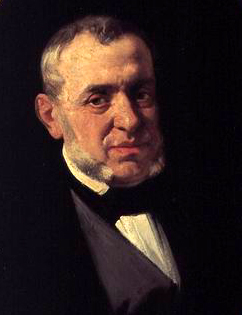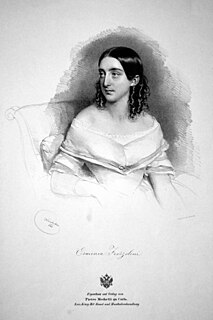
In the ancient Roman legend of the kingdom era, the Horatii were triplet warriors who lived during the reign of Tullus Hostilius. The accounts of their epic clash with the Curiatii and the murder of their sister by Publius, the sole survivor of the battle, appear in the writings of Livy.

Oath of the Horatii, is a large painting by the French artist Jacques-Louis David painted in 1784 and now on display in the Louvre in Paris. The painting immediately became a huge success with critics and the public, and remains one of the best known paintings in the Neoclassical style.

Salvadore Cammarano was a prolific Italian librettist and playwright perhaps best known for writing the text of Lucia di Lammermoor (1835) for Gaetano Donizetti.

Nelly Miricioiu is a Romanian-born British operatic soprano singing a large repertoire ranging from bel canto to verismo.

The Teatro Comunale in Ferrara is an opera house, located in the Italian region of Emilia-Romagna, and built between 1786 and 1797 with seating for 990. Privately owned theatres with limited seating capacity had existed in the city for many years, but the arrival of Cardinal Spinelli, the new papal envoy, in 1786 spurred the construction of a new public theatre under the architects Cosimo Morelli and Antonio Foschini. However, their disagreements led to conflicting design concepts regarding the elliptical shape of the auditorium which were resolved through compromise. The theatre was finally ready for its inaugural presentation of Portogallo’s Gli Orazi e i Curiazi on 2 September 1798.

Orazi e Curiazi is an opera by the Italian composer Saverio Mercadante. It takes the form of a tragedia lirica in three acts. The libretto, by Salvadore Cammarano, is based on the Roman legend of the fight between Horatii and Curiatii. It was first performed at the Teatro San Carlo, Naples, on 10 November 1846.

Giuseppina Maria CamillaGrassini was a noted Italian contralto, and a singing teacher. She was also known for her affairs with Napoleon and the Duke of Wellington. She sang in various productions by composers such as Cimarosa, Cherubini and Zingarelli.

Gli Orazi e i Curiazi is an opera in three acts composed by Domenico Cimarosa to a libretto by Antonio Simeone Sografi, based on Pierre Corneille's tragedy Horace.
Matteo Antonio Babini, also known by the family name of Babbini, was a leading Italian tenor of the late 18th-century, and a teacher of singing and stage art.

Anna Caterina Antonacci is an Italian soprano known for roles in the bel canto and Baroque repertories. She performed as a mezzo-soprano for several years, particularly performing the Rossini canon.

Horace is a play by the French dramatist Pierre Corneille, drawing on Livy's account of the battle between the Horatii and the Curiatii. Written in reply to critics of his Le Cid, it was dedicated to cardinal Richelieu and proved the author's second major success on its premiere in March 1640. Its protagonist Horatius is more daring than Rodrigue in Le Cid, in that he sacrifices his best friend and kills his sister Camilla. It was the basis for the libretti for the operas Les Horaces and Gli Orazi e i Curiazi. It is considered one of Corneille's great tragedies.
The gens Curiatia was a distinguished family at Rome, with both patrician and plebeian branches. Members of this gens are mentioned in connection with the reign of Tullus Hostilius, the third King of Rome, during the seventh century BC. The first of the Curiatii to attain any significant office was Publius Curiatius Fistus, surnamed Trigeminus, who held the consulship in 453 BC. The gens continued to exist throughout the Republic, and perhaps into imperial times, but seldom did its members achieve any prominence.
Marco Arati was an Italian operatic bass active during the 1840s through the 1880s. Although he occasionally appeared at other opera houses in Italy, he was primarily committed to the Teatro di San Carlo where he sang roles for more than four decades. Even though he was one of the preeminent singers of his day, there is little known about his life.

The gens Horatia was a patrician family at ancient Rome. In legend, the gens dates back to the time of Tullus Hostilius, the third King of Rome. One of its members, Marcus Horatius Pulvillus, was consul suffectus in 509 BC, the first year of the Republic, and again in 507. The most famous of the Horatii was his nephew, Publius Horatius Cocles, who held the Sublician bridge against the army of Lars Porsena circa 508 BC.
Janet Price is a Welsh soprano particularly associated with the 19th-century Italian bel canto repertory. She has been married to composer Adrian Beaumont since 1963.

Erminia Frezzolini was an Italian operatic soprano. She excelled in the coloratura soprano repertoire, drawing particular acclaim in the bel canto operas of Gaetano Donizetti and Vincenzo Bellini. She was married to tenor Antonio Poggi from 1841-1846.

Duel of Champions is a 1961 film about the Roman legend of the Horatii, triplet brothers from Rome who fought a duel against the Curiatii, triplet brothers from Alba Longa in order to determine the outcome of a war between their two nations.

The Statue of Urban VIII is a large statue from the late 1630s, of the then pope Urban VIII. It was executed by Gian Lorenzo Bernini and his workshop. The work was commissioned in 1635 and took five years to complete. The piece sits in the Palazzo dei Conservatori in Rome. A print of the statue exists in the National Library of Austria.
Publius Curiatius Fistus Trigeminus, or Publius Horatius Pulvillus, was a Roman politician in the 5th century BC, consul in 453 BC, and decemvir in 451 BC.













